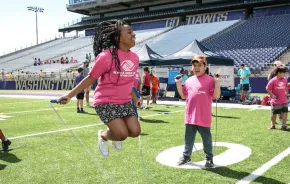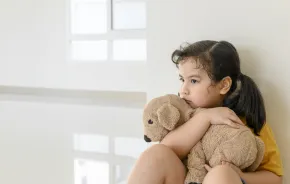
Photo:
iStock
Editor’s note: This article was sponsored by Seattle Children’s Hospital.
When educator Faith Eakin was working at a Seattle youth nonprofit, a student’s mother shared some troubling information. The family was new to the country and was experiencing racism and discrimination. The mom worried about the impact of these experiences on her young child.
Eakin listened and validated the mom’s experiences and worries. Then, in addition to offering other supports, asked the mom whether the child had any connections to the broader community. The mom brightened and shared details of their new church as well as cultural community events in which they participated.
“You could feel an emotional lift in the conversations,” says Eakin, who now works in community mental health at Seattle Children’s Hospital. “When you talk about positive experiences, parents inflate a little and there’s more hope in the room.”
Shifting conversations like these beyond trauma to identify and cultivate positive childhood experiences (PCEs) can help children develop resilience and grow into healthy adults. That approach, known as Healthy Outcomes from Positive Experiences (HOPE), focuses on building good experiences in a child’s life that can mitigate the negative health impact of traumatic ones. By creating moments of strength, families and their partners can sow the seeds of wellbeing, resilience and healing.
“HOPE is creating more of a focus on positive childhood experiences,” says Beth Crispin, the community health program manager for Seattle Children’s. “We can’t do much to change what happened to a child or family in the past, but we can impact access to positive childhood experiences.”
Positive experiences can reduce trauma
In recent years, there has been a growing movement to identify adverse childhood experiences (ACEs) and investigate the long-term health impacts. ACEs can include experiencing violence, abuse or neglect as well as witnessing violence in one’s home or community. It can arise when children don’t have enough food to eat or if they experience discrimination. Numerous studies have shown ACEs are linked to poorer physical and mental health later in life, including higher rates of chronic illness, poor mental health and greater substance use.
As ACEs research has mounted, people who work with children often experience a sense of hopelessness, Crispin explains.
“Teachers and other caregivers are feeling the heaviness of ACEs and asking, ‘Now, what?’” she says. “The HOPE framework is giving them the answer.”
In fact, a JAMA Pediatrics article noted that proactively promoting PCEs may reduce adult mental and relational health problems — even if a child also experienced adverse events. “Even as society continues to address remediable causes of childhood adversities such as ACEs, attention should be given to the creation of those positive experiences that both reflect and generate resilience within children, families and communities,” the authors wrote.
With the HOPE approach, which emerged from Tufts Medical Center, parents and caregivers, educators, health professionals, and community groups seek ways to create and strengthen positive childhood experiences in four key categories: relationships and social connections; environment; engagement; and emotional growth.
How do you create HOPE?
Creating PCEs doesn’t require a trip to Disneyland or a new puppy, Crispin says. For children, small moments of connections — such as a secret handshake shared with a caregiver — can have an outsized impact. Often, these moments of connection are already happening.
“It’s not an extra thing or a checklist,” Crispin says. “It’s about reframing much of what parents are already doing,” she says.
Eakin recalls a conversation with a family in which she asked for examples of how they spent time together. While the parents pointed to a big spring break trip, the child separately described the simple activity of picking out school pencils together at Target.
For other families, PCEs might be working through social and emotional challenges together. Parents might embrace mindfulness through breathing activities such as pretending to “blow out the candles,” a calming tool to use during dysregulated moments. For others, it might be simply spending time with a child and fully listening to them.
“Kids can feel when you’re connecting and really listening,” she says. “HOPE is a chance to slow down and identify the areas when you can bring peace; all of these little moments add up.”
These connections can also come from other trusted and safe community or family members, such as an aunt, neighbor, faith leader, coach or teacher. The quantity of the interactions matters less than the quality. If a parent can’t think of an adult, they can brainstorm some ideas with their child. In Crispin’s own life, a child librarian built a special connection with her son.
Feeling valued as a part of a larger community can also shape a child’s wellbeing. Even something as seemingly simple as a neighborhood potluck can influence a child’s brain architecture, Crispin says. This engagement can also come via playing on a sports team or a festival celebrating someone’s culture and ethnicity.
“They’re connected to something larger than themselves,” she said. “They feel the value of being seen.”
Sharing the approach
At Seattle Children’s, health facilitators are working to spread awareness of the HOPE approach to community-based organizations that work with children as well as with providers and parents. The framework offers a chance to pause and reflect on positive moments individuals and organizations are already creating as well as opportunities to generate new ones.
Much like parent interactions, small shifts can create a big impact on a child. When the Seattle Children’s Community Health Team plans future outreach events, they’ll be keeping an eye out for ways to create positive experiences. At a bike helmet safety event, for example, they might include a small game that families can play together. Even just posing a simple discussion question on a whiteboard can generate that small moment, such as asking participants: How do you know when someone is a good friend?
The shift toward positive experiences not only helps children facing ACEs, but caregivers who are burned out worrying about the youth they encounter.
“This is so hopeful,” Eakin says. “This framework provides the opportunity to see that these little moments are everywhere.”
Please email Seattle Children’s Community Health and Benefit to learn more about PCEs and HOPE.
Ways to build routines that foster positive childhood experiences:
Adapted from Tufts Medical Center |
|
Sponsored by: |












